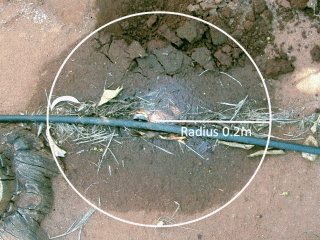Water held in root zone
The volume of root zone that is wetted by the drip system will depend on the size and shape of the wetting pattern.
Overlapping drippers
Where drip patterns overlap, assume that a wetted strip or sausage-shaped wetted pattern is produced (see Figure 1).
The volume of water held in the soil can be estimated from the width and length of the wetted strip and the Readily Available Water (RAW) in the root zone.
Volume stored (L) = wetted width (m) x wetted length (m) x root zone RAW (mm)
For example, for a width of 1.5m wetted, 3m tree spacing and root zone RAW of 14mm, the volume of Readily Available Water = 1.5 x 3 x 14 = 63 litres of RAW per tree.
If the crop root zone does not access the entire wetted strip, adjust the dimensions of the wetted area in your calculation. This is particularly important in young plantings where roots may have access to only a small portion of the wetted strip.
Non-overlapping drippers
Where wetting patterns do not overlap, calculate the wetted volume assuming a cylinder, sphere or cone-shaped wetting pattern (see Figure 2).
For example, if a root zone with a RAW of 14mm is wet by a dripper with a cylindrical wetting pattern and a radius of 0.2m, the volume of readily available water will be:
πr2 x root zone RAW (mm)
(πr2 is the area of a circle where pi (π) equals 3.14.)
3.14 x (0.2 x 0.2) x 14 = 1.8L/dripper.
If there is more than one dripper per plant, multiply this figure by the number of drippers to get the total litres available to each plant.


